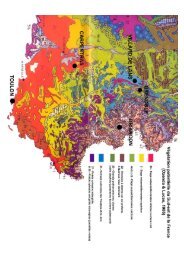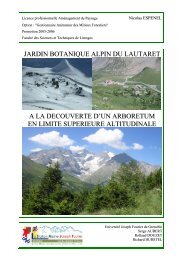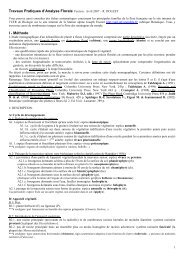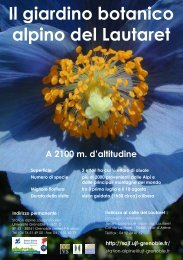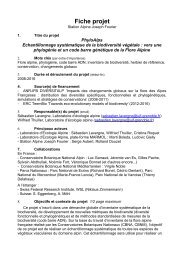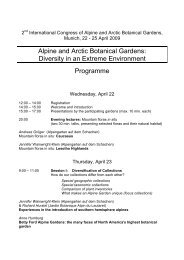Rannunculus Anglais - Station Alpine Joseph Fourier
Rannunculus Anglais - Station Alpine Joseph Fourier
Rannunculus Anglais - Station Alpine Joseph Fourier
Create successful ePaper yourself
Turn your PDF publications into a flip-book with our unique Google optimized e-Paper software.
Project Description<br />
<strong>Joseph</strong> <strong>Fourier</strong> <strong>Alpine</strong> <strong>Station</strong><br />
Project Title: The role of the antioxidants ascorbate and glutathion in the stress resistance of<br />
S. alpina and R. glacialis<br />
Key Words: ascorbate, glutathion, photoinhibition, low temperatures, high temperatures<br />
Project Leader: Peter STREB (peter.streb@u-psud.fr)<br />
Principal Participants: Peter Streb (Plant ecophysiology laboratory, university Paris XI)<br />
Collaborations: Richard Bligny (PCV laboratory)<br />
Project Objectives and Context : The two alpine plants Soldanella alpina and Ranunculus<br />
glacialis contain very different concentrations of antioxidants within their leaves. The<br />
concentration of antioxidants and the activity of antioxidant enzymes are often correlated with<br />
the resistance of acclimatised leaves to stress due to cold and intense light. In particular, the<br />
concentration of ascorbate is exceptionally high in leaves of S. alpina, while it remains<br />
relatively low in R. glacialis. Nevertheless, these two plants both tolerate stresses due to cold<br />
temperatures and high light. Consequently tolerance to these stresses does not only depend on<br />
the capacity of the antioxidant system. These results pose the question of what is the role of<br />
antioxidants in resistance to cold and high light versus other forms of stress found at high<br />
altitude.<br />
Due to global climatic change temperatures are increasing in the alpine region. During 2003<br />
on certain days maximum temperatures reached 40°C at 2300m. We have shown that such<br />
temperatures, coupled with high light intensities, result in photoinhibition in S. alpina and R.<br />
glacialis, with a stronger effect in leaves of R. glacialis than in those of S. alpina. This<br />
observation poses the question of whether high concentrations of antioxidants play a more<br />
important role in the protection of leaves under high temperatures than under low<br />
temperatures. S. alpina retains its green leaves over winter and flowers in springtime while<br />
still covered by snow. In contrast, R. glacialis survives over winter only as underground<br />
organs. The high concentration of ascorbate in the leaves of S. alpina is likely due to the fact<br />
that this plant continues photosynthetic activity over winter, under the snow pack, despite low<br />
temperatures (melting snow) and very high light intensities.<br />
Concentrations of ascorbate and glutathion (reduced AA, GSH and oxide DHAA,<br />
GSSG) in leaves of S. alpina and R. glacialis, in mol per mg chlorophyll<br />
Possible Roles of Ascorbate<br />
• Increases tolerance to photoinhibition due to low or high temperatures?<br />
• Linked to protein synthesis?<br />
• Allows the survival of leaves over winter?<br />
• Allows early flowering?
Approaches / Methods: Climatic parameters and concentrations of antioxidants are being<br />
measured throughout the year. The objective is to determine the conditions which induce the<br />
greatest accumulation of antioxidants in S. alpina and to observe the resulting effects on stress<br />
resistance, leaf survival over winter and on flowering. The concentrations of ascorbate are<br />
increased in the presence of the acid L-galactonic γ lactone, a precursor in the synthesis of<br />
ascorbate. Concentrations of glutathion are decreased in the presence of DL buthionine<br />
sulfoximine, an inhibitor of the synthesis of glutathion. Leaves containing varying<br />
concentrations of anti oxidants are exposed to low and high temperatures coupled with high<br />
light intensities to study the role of antioxidants in stress tolerance.<br />
Expected Results: Modification of the foliar concentration of antioxidants in vivo allows<br />
measurement of the role of anti oxidants in stress tolerance. In particular, a low concentration<br />
of ascorbate and glutathion will show if these anti oxidants are necessary for the protection of<br />
S. alpina against high light intensities, low temperatures or high temperatures. Similarly, it<br />
will be possible to determine if ascorbate is necessary for the survival of leaves of S. alpina<br />
under the snow pack over winter allowing photosynthesis and early flowering. A high (or<br />
low) concentration of antioxidants in R. glacialis will show their role in protecting leaves<br />
from the same stresses, and in particular to high temperatures. We hope to understand if a<br />
high concentration of antioxidants favours resistance in the face of global climatic change and<br />
if antioxidant protection systems can ameliorate the survival of plants in the case of<br />
continuing increases in temperature in alpine regions.<br />
Bibliography<br />
Streb P, Feierabend J, Bligny R. (1997) Resistance to photoinhibition of photosystem II and<br />
catalase and antioxidative protection in high mountain plants. Plant Cell Environ. 20:<br />
1030-1040<br />
Streb P, Shang W, Feierabend J, Bligny R. (1998) Divergent strategies of photoprotection in<br />
high-mountain plants. Planta 207: 313-324<br />
Streb P, Aubert S, Gout E, Bligny R (2003a) Reversibility of cold- and light-stress tolerance<br />
and accompanying changes of metabolite and antioxidant levels in the two high mountain<br />
plant species Soldanella alpina and Ranunculus glacialis. J. Exp. Bot. 54: 405-418<br />
Streb P, Aubert S, Gout E, Bligny R. (2003b) Cold- and light-induced changes of metabolite<br />
and antioxidant levels in two high mountain plant species Soldanella alpina and<br />
Ranunculus glacialis and a lowland species Pisum sativum. Physiol. Plant. 118: 96-104<br />
Streb P, Aubert S, Bligny R (2003c) High temperature effects on light sensitivity in the two<br />
high mountain plant species Soldanella alpina (L) and Ranunculus glacialis (L). Plant<br />
Biol. 5, 432-440<br />
Streb P, Josse EM, Gallouët E, Baptist F, Kuntz M, Cornic G. (2005) Evidence for alternative<br />
electron sinks to photosynthetic carbon assimilation in the high mountain plant species<br />
Ranunculus glacialis. Plant, Cell Environment 28, 1123-1135



